Online Course
NRSG 780 - Health Promotion and Population Health
Module 3: Epidemiology
History of Epidemiology
Epidemiology is defined as the study of the distribution and determinants of disease in populations
Source: MacMahon, B. & Trichopoulos, D. (1996). Epidemiology: principles and methods. (2nd ed.).London: Little, Brown, & Co.
Epidemiology is used to:
- Determine the distribution and frequency of various diseases and health problems in the population
- Identify the cause(s) of various diseases and identify risk factors, which increase the risk of developing those diseases
- Understand the natural history and prognosis of various diseases
- Evaluate the effect(s) on health status of preventive measures, medical therapies and health care delivery systems
- Provide a scientific basis for sound decision-making in public health and clinical care
Source: Gordis, L. (2008). Epidemiology, (4th ed.). Philadelphia: W.B. Saunders.
Epidemiological investigations have and continue to help us study a variety of problems that include questions like:
- What causes coronary heart disease?
- Can diabetes be prevented? If so, how?
- What can individuals do to increase their lifespan?
- Does taking aspirin affect the risk of developing colon cancer?
- Is hypertension more common in Baltimore than the rest of Maryland?
- How many people in Maryland suffer from depression?
- What made Uncle Harry sick after the picnic last Sunday?
The American Public Health Association believes that it is critical to gain an appreciation for the key figures and events in the development of the field of epidemiology. The following is a brief synopsis of its history.
Hippocrates – First Epidemiologist

Hippocrates is often referred to as the first epidemiologist. In 400 BC he wrote in On Air, Water and Places, a careful description of what we now refer to as the key epidemiological variables – Person, Place and Time.
Hippocrates stated,
Whoever wishes to investigate medicine properly, should proceed thus: in the first place to consider the seasons of the year, and what effects each of them produces for they are not at all alike, but differ much from themselves in regard to their changes. Then the winds, the hot and the cold, especially such as are common to all countries, and then such as are peculiar to each locality. We must also consider the qualities of the waters, for as they differ from one another in taste and weight, so also do they differ much in their qualities. In the same manner, when one comes into a city to which he is a stranger, he ought to consider its situation, how it lies as to the winds and the rising of the sun; for its influence is not the same whether it lies to the north or the south, to the rising or to the setting sun. These things one ought to consider most attentively, and concerning the waters which the inhabitants use, whether they be marshy and soft, or hard, and running from elevated and rocky situations, and then if saltish and unfit for cooking; and the ground, whether it be naked and deficient in water, or wooded and well watered, and whether it lies in a hollow, confined situation, or is elevated and cold; and the mode in which the inhabitants live, and what are their pursuits, whether they are fond of drinking and eating to excess, and given to indolence, or are fond of exercise and labor, and not given to excess in eating and drinking
Key Figures and Events
The rise and fall of many civilizations can be understood in terms of their ability to protect the health of the population. Moving forward 2000 years…
In the mid-1600s, in an era when disease was often attributed to poor moral or spiritual character, and well before the germ theory was developed,
- Thomas Sydenham distinguished and described numerous infectious disease symptoms.
- William Petty and John Graunt began to carefully analyze mortality data.
- William Farr developed statistical approaches to data analysis and occupational mortality. He also developed a revolutionary system for the categorization of disease. This became the foundation for the WHO ICD codes that we still use today. The ICD codes are remarkably only in their 10th edition since their origin in the mid-1600s.
John Snow 1813-1858
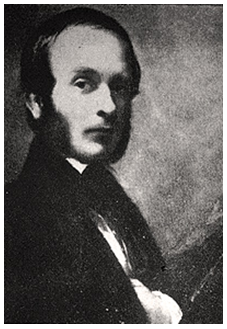 In the mid-1800s, John Snow, an anesthetist, often referred to as the father of epidemiology, conducted his landmark studies of cholera in London.
In the mid-1800s, John Snow, an anesthetist, often referred to as the father of epidemiology, conducted his landmark studies of cholera in London.
He reported, The most terrible outbreak of cholera which ever occurred in this kingdom, is probably that which took place in Broad Street, Golden Square, and the adjoining streets, a few weeks ago. Within two hundred and fifty yards of the spot where Cambridge Street joins Broad Street, there were upwards of five hundred fatal attacks of cholera in ten days. The mortality in this limited area probably equals any that was ever caused in this country, even by the plague; and it was much more sudden, as the greater number of cases terminated in a few hours.
Polluted Drinking Water from Thames:
Could it be related to Cholera Epidemics?

His investigation began to center on the possible connection between water from the Broad Street pump and the cholera epidemic. Snow wondered it was about the water:
The sewer passes within a few yards of the well. The water at the time of the cholera contained impurities of an organic nature, in the form of minute whitish flocculi visible on close inspection to the naked eye. Dr. Hassall, who was good enough to examine these particles … found a great number of very minute oval animalcules in the water and deemed the animalcules to be of no importance at the time….
Despite this conclusion and prompted by John Snow’s inquiry, the local officials decided to disable the Broad Street pump by removing the handle, which turned out to be a key factor in ending the epidemic.

To learn more about this remarkable scientist, please review the Case Study in Public Health on John Snow, Cholera, the Broad Street Pump; Waterborne Diseases Then and Now at https://pmc.ncbi.nlm.nih.gov/articles/PMC7150208/.
Edwin Chadwick & Lemuel Shattuck
Edwin Chadwick and Lemuel Shattuck are identified as the founders of the modern era of public health.
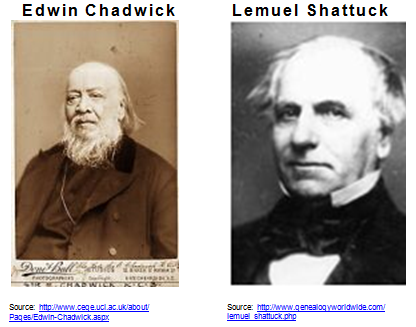
Chadwick’s colorful report on the “Sanitary Conditions of the Labouring Classes in Great Britain” in 1842 paid special attention to the working conditions and mortality of child laborers as young as five. It was widely distributed and ultimately shifter public consciousness from thinking that poverty and disease were individual concerns, to recognizing that they were critical problems that affected the well-being of the nation and required national legislation.
Shattuck’s “Report of the Sanitary Commission of Massachusetts” written in 1850 was much drier. Although it was well received by the medical community and published in the New England Journal of Medicine, it wasn’t until 20 years later that it received broad public acceptance. To this day, many of its 19 recommendations serve as the foundation of public health practice across the world. They include:
- Establish state and local boards of health
- Collect and analyze vital statistics
- Exchange health information
- Initiate sanitation programs for towns and buildings
- Maintain a system of sanitary inspections
- Study the health of schoolchildren
- Conduct research on tuberculosis
- Study and supervise health conditions of immigrants
- Supervise mental disease
- Control alcoholism
- Control food adulteration
- Control exposure to nostrums
- Control smoke nuisances
- Construct model tenements
- Construct standard public bathing and washhouses
- Preach health from the pulpit
- Teach the science of sanitation in medical schools
- Introduce prevention in all phases of medical practice
- Sponsor routine health examinations
Florence Nightingale
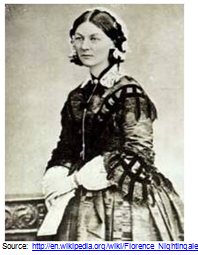 Although not given proper due as an epidemiologist in the nursing literature, Florence Nightingale was a huge intellect in the field.
Although not given proper due as an epidemiologist in the nursing literature, Florence Nightingale was a huge intellect in the field.
Her careful month-by-month analysis of the causes of mortality during the Crimean War, and her startling diagrams referred to as coxcombs, led to the realization that soldiers were not dying primarily of war wounds, as expected, but from infection which resulted from the close living quarters, the unsanitary conditions and the poor food supply.
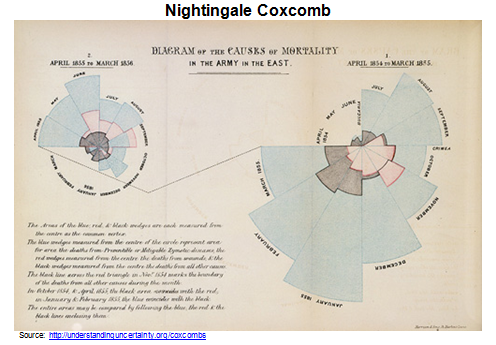

Florence Nightingale was a leading member and the first woman invited to join the prestigious London Epidemiological Society begun in 1850.
Pasteur, Koch, Lister & Goldberg
Soon afterwards, the remarkable discovers of Pasteur, Koch and Lister led to the Germ Theory of Disease. Specific microbiological pathogens were recognized and ways of increasing host resistance and decreasing disease transmission were identified.
In 1919, Joseph Goldberg demonstrated that Pellagra was due to a nutritional deficiency, not an infectious agent.
Framingham Heart Study
 In 1948, the Framingham Heart Study was initiated by the NIH to ascertain whether heart disease was an inevitable outcome of aging or if certain risk factors increased the risk for heart disease and stroke. This cohort study and its next generation studies remain ongoing, over 60 years later. The Framingham Study has resulted in over 1000 papers and landmark evidence regarding the risk for heart disease, stroke and many other chronic diseases.
In 1948, the Framingham Heart Study was initiated by the NIH to ascertain whether heart disease was an inevitable outcome of aging or if certain risk factors increased the risk for heart disease and stroke. This cohort study and its next generation studies remain ongoing, over 60 years later. The Framingham Study has resulted in over 1000 papers and landmark evidence regarding the risk for heart disease, stroke and many other chronic diseases.
Wynder, Hill, & Doll - Smoking and Lung Cancer
By 1950, Ernst Wynder, Bradford Hill and Richard Doll identified the strong link between cigarette smoking and lung cancer. Not until 14 years later did the U.S. Surgeon General issue the first report on Smoking and Health.

Salk Polio Vaccine
Jonas Salk discovered and developed the first polio vaccine. When asked who owned the patent on his vaccine, he responded, “The people I would say. There is no patent. Could you patent the sun? Watch this short video on the impact of the vaccine worldwide.
On the 10th anniversary of President Franklin Roosevelt’s death, Dr. Thomas Francis announced the results of the Salk Polio Vaccine Field Trials identifying the safety of the vaccine. For more information on polio, its devastation, treatment strategies, such as the iron lung noted in the photo, the vaccine and the 50th anniversary announcement, go to this website.

Eradication of Smallpox
In 1980, WHO declared that smallpox was eradicated.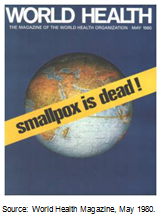
With the issuing of the Surgeon Generals’ first report in 1979 on health promotion and disease prevention, Healthy People, “ a new period in the modern era of public health began. A companion document entitled, “Objectives for the Nation” was prepared to establish goals and objectives for achieving a second public health revolution – the control of chronic disease.Now in its 5th iteration, Healthy People 2030 forms the national health promotion agenda for the nation.
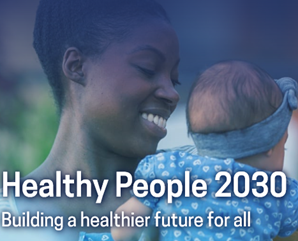
This website is maintained by the University of Maryland School of Nursing (UMSON) Office of Learning Technologies. The UMSON logo and all other contents of this website are the sole property of UMSON and may not be used for any purpose without prior written consent. Links to other websites do not constitute or imply an endorsement of those sites, their content, or their products and services. Please send comments, corrections, and link improvements to nrsonline@umaryland.edu.